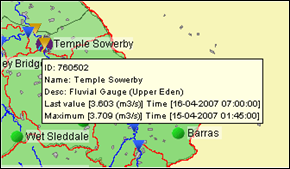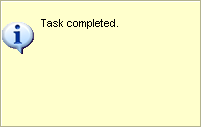| Wiki Markup |
|---|
{scrollbar} |
| Table of Contents |
|---|
| Children Display |
|---|
FEWS Explorer
Overview
FEWS Explorer is the principal window of Delft FEWS. The main elements of FEWS Explorer are highlighted in the figure below.
...
Map navigation options are set in the zoom toolbar item. After clicking the ''button you can manually zoom in to a user defined map area. With the '-' button you can zoom out. Panning is possible after having clicked the hand button. From version 2008-01 the zoom in, zoom out and pan have been combined. After selecting the '' button, drawing a box from top left to bottom right zooms in, while bottom right to top left zooms out. Holding down the right mouse button allows you to pan. The buttons for zoom out and pan remain for users with only one mouse button.
...
Alternatively, zooming can be done with help of the scroll wheel on the mouse (when available). Zooming in and out is done by respectively turning the scroll wheel away and towards for the user. The position of the cursor determines the centre point of the zoom action.
Selecting locations and parameters
Locations in the Map Display can be selected by clicking on their icon. When selecting a location in this fashion, the locations selected in the Filters (to the left of the map display) will be adjusted to correspond with the map display. Conversely, if a location is selected in the Filters, the selection in the Map View will be adjusted as well. Multiple locations can be selected by holding down the [CTRL ] key while selecting.
Parameters can be selected in the filter box bellow the locations filters. It's also possible to select multiple parameters by holding down the [CTRL ] key while selecting.
In the Button Bar, there is a section further aiding location and parameter selection.
Rectangle selection: When selected allows you to press left mouse button and drag to create a rectangular box over the Map Display. When released it will select all locations contained in the rectangle. | |
Lasso selection: When selected allows you to create a freehand selection in the Map Display. Press and hold the left mouse button and drag around the locations you want selected. Release to make the selection. | |
Add location parameter selection: Stores the current Map Display location and parameter selection. A Pop-up will allow you to enter a name for this selection. After entering the name and pressing OK, the selection can be found in the dropdown box to the right. | |
Removes location parameter selection: Removes the current item in the location and parameter selection dropdown box to the right of this icon. If there is no current item, or it is empty, nothing will happen. | |
Location parameter selection dropdown: When selecting an item from this dropdown, the locations and parameters contained in that item will be selected in the Map Display and the Filters. Selections can be added or removed with the Add / Remove location selection buttons. |
The stored selections endure a restart of FEWS and will only be deleted by manually removing them or when overwritten.
Show map layer information
...
An example is given below;
| Info |
|---|
The tooltip shown above is the default tooltip. Within Delft-Fews it is possible that the tooltip has been configured differently to e.g. display a picture of the location. Consult the documentation of your local system or the Delft-Fews configuration guide (locations) for more information. |
Filters
The filters are the 4 list boxes at the left hand side of the FEWS Explorer. The filters are used to select the data to be displayed in a graph or table. Your selection can be filtered by making one of more choices in the list boxes.
...
Since 2007.02, the Explorer can be configured to provide a popup type notification to show completion of manually dispatched tasks. The popup appears in the lower left screen corner, reporting the name of the job dispatched as well as its success or failure.










